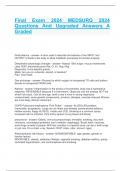Final Exam 2024 MEDSURG 2024 Questions And Upgraded Answers A Graded Fluid balance - answer --A ter m used to describe the balance of the INPUT and OUTPUT of fluids in the body to allow metabolic processes to function properly. Dehydration physiologic changes - answer --Assess - Skin turgor, mucus membranes Labs: BUN, electrolyte panel (Na, Cl, K), Hcg, H bg. Diagnostic: Urine specific gravity Meds: Are you on a diuretic, steroid, or laxative? Plan: Give fluids Gas exchange - answer --Process by which oxygen is transported TO cells and carbon dioxide is transported FROM cells. Asthma - answer --Inflammation in the airway or bronchioles, body has a hyperactive response. REVERSIBLE because it is intermittent. Obstructs only the airways NOT the alveoli (air sacs). Can be any age, tend to see it more in young respiratory compromised, some genetic components, smo kers, allergies, exercise induced. Women are more likely (African American) COPD Pulmonary emphysema "Pink Puffer" - answer --ALVEOLAR problem, irreversible, progressive. Lungs do not inflate and deflates (overstretched balloon). Hollow sounds, floppy ALVE OLI. Holds onto CO2. Smoking is a common cause. Increased risk for infection. Pink frothy sputum (Lung tissue and blood) pneumonia - answer --Elderly, immunocompromised, immobile, smoking, recurrent infections, neurological problems (can't swallow - dysphag ia). Brush teeth, vaccines, avoid large crowds of people. Will hear crackles in a specific area, can be in both lungs or just one. Do a chest x -ray. Sputum COAT (color, odor, amount, type) Atherosclerosis risk factors - answer --NONMODIFIABLE - age, gender, genetic or familiar factors. MODIFIABLE - obesity, sedentary lifestyle, cigarette smoking, diabetes mellitus, poorly controlled hypertension, oral contraceptives and smoking. Coronary artery disease risk factors - answer --Diabetes mellitus #1, tobacco smo king, hypertension, hyperlipidemia, family history of premature CAD, age, leading cause of death in US, high cholesterol Hypertension risk factors - answer --Obesity, age, ethnicity, high stress, smoking and alcohol Na+ - answer --135-145 mEq/L K+ - answer --3.5-5.0 mEq/L Ca+ - answer --9.0-10.5 mEq/L Mg+ - answer --1.3-2.1 mEq/L Cl- - answer --98-106 mEq/L Phos - answer --2.5-4.5 mg/dL Bicarb - answer --Depends on scenario What affects electrolyte concentrations? - answer --Age, gender, body fat, fluid intake, fluid loss Fluid loss: Obligatory Urine Output - answer --Minimum urine amount needed to excrete toxic waste products = 400 -600 mL/day Fluid loss: Insensible Water Loss - answer --Skin, lungs, GI tract Urine output for optimal kidney functi on - answer --30 mL/hr Doughnut (cell is happy) - answer --ISO Flat object (pancake) - answer --HYPER Round object (ball or hippo) - answer --HYPO Isotonic - answer --NS (0.9%) LR Hypotonic - answer --Less than 0.9% NS -water -0.45 NS Hypertonic - answer --Greater than 0.9% NS -D5 -D10 What do you add to a flat hyper cell? - answer --Hypotonic solutions What do you add to shrink a hypo/hippo cell? - answer --Hypertonic solutions Why give fluids to a patient? - answer --To re -hydrate thei r cells and correct any fluid imbalance main problem electrolytes - answer --sodium, potassium, calcium Helper electrolytes - answer --phosphorus, magnesium, chloride Married couple electrolytes - answer --Na & Cl (deal with fluid balance) Ca & Mg (muscle functions) Follower electrolyte - answer --potassium Runner (does opposite) - answer --Phosphorus Dehydration - risk factors/population at risk - answer --elderly, babies, healthy people Most reliable indicator of fluid status - answer --WEIGHT 1 L of fluid - answer --Equates to 2.2 lbs What electrolytes would we check for fluid balance concerns? - answer --Sodium and Chloride Overhydration risk factors/population - answer --CHF, impaired kidney function, long term steroid use Overhydration physi ological changes - answer --Assess: edema, weight gain, lung crackles Labs: BUN electrolyte panel (Na, Cl, K), Hcg, Hbg Diagnostic: Urine specific gravity Meds: Are you on a diuretic, steroid, or laxative? Plan: Hypertonic fluids (D5), lasix, daily weights Hypocalcemia - answer --Trousseau's sign (blood pressure twitch) Chvostek's sign (facial twitches) While monitoring a patient who has fluid overload, which assessment is most concerning to the nurse? - answer --Crackles in the lungs




